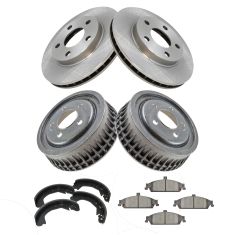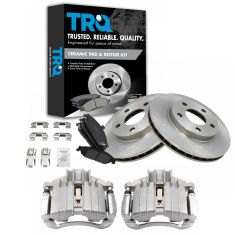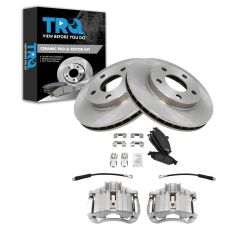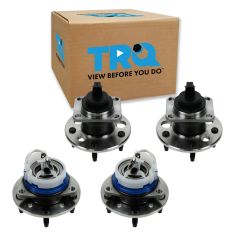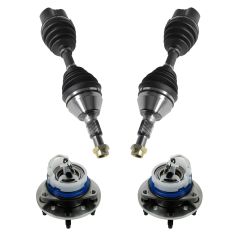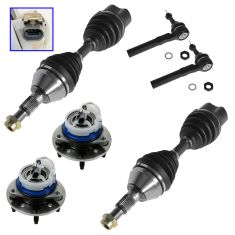Replaces
2004 Olds Alero Front Ceramic Brake Pad & Rotor Kit with Wheel Bearings TRQ BKA52047
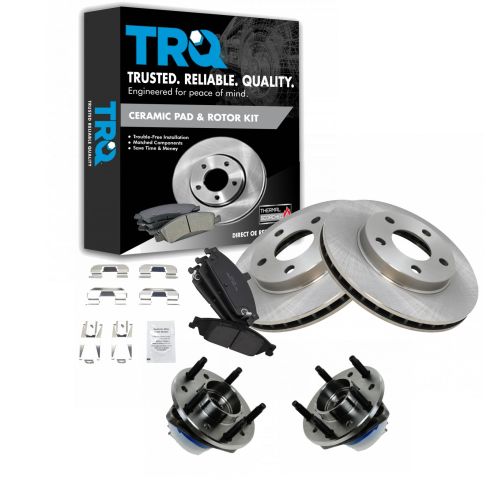
BKA52047
This part doesn’t fit a . Select from parts that fit.
Specify your vehicle's year, make and model to guarantee fit.
This part does not fit a .
Buy in the next and
Get it by: Tuesday, Dec 16 with expedited shipping
You may also like
Part Details
- (2) Front Brake Rotors
- (2) Front Wheel Bearing & Hub Assemblies
- (1) Front Ceramic Brake Pad Set
- Ceramic
- Ball Bearing
Specifications
- Front
About TRQ:
TRQ is a trusted brand dedicated to making every repair a success story by combining premium parts with easy installation. Each TRQ part is engineered by a team of automotive experts to meet or exceed OEM standards, delivering enhanced performance and maximum longevity. With rigorous in-house testing, the brand ensures superior fit and function across every product line. TRQ also provides customers with best-in-class, step-by-step installation videos—so you can complete repairs with confidence, whether you're a first-time DIYer or an industry professional.
Product Features
TRQ brake kits are designed to restore your brake system to like-new performance. TRQ brake pads are positive molded, thermal scorched, chamfered, and utilize a multi-layer shim for enhanced performance and service life. TRQ rotors have a non-directional finish that reduces the break-in period for new rotors as well as reducing vibrations throughout the rotor’s lifecycle. All products are fit and road-tested in our Massachusetts R&D facility to ensure we deliver on our promise of Trusted Reliable Quality.
Attention California Customers:
![]() WARNING: This product can expose you to chemicals including Lead and Lead Compounds, which are known to the State of California to cause cancer, and birth defects or other reproductive harm. For more information, go to www.P65Warnings.ca.gov.
WARNING: This product can expose you to chemicals including Lead and Lead Compounds, which are known to the State of California to cause cancer, and birth defects or other reproductive harm. For more information, go to www.P65Warnings.ca.gov.
Lifetime Warranty
This item is backed by our limited lifetime warranty. In the event that this item should fail due to manufacturing defects during intended use, we will replace the part free of charge. This warranty covers the cost of the part only.
FREE Shipping is standard on orders shipped to the lower 48 States (Contiguous United States). Standard shipping charges apply to Hawaii and Alaska.
Shipping is not available to a P.O. Box, APO/FPO/DPO addresses, US Territories, or Canada for this item.
Expedited is available on checkout to the United States, excluding Alaska, Hawaii.
Final shipping costs are available at checkout.





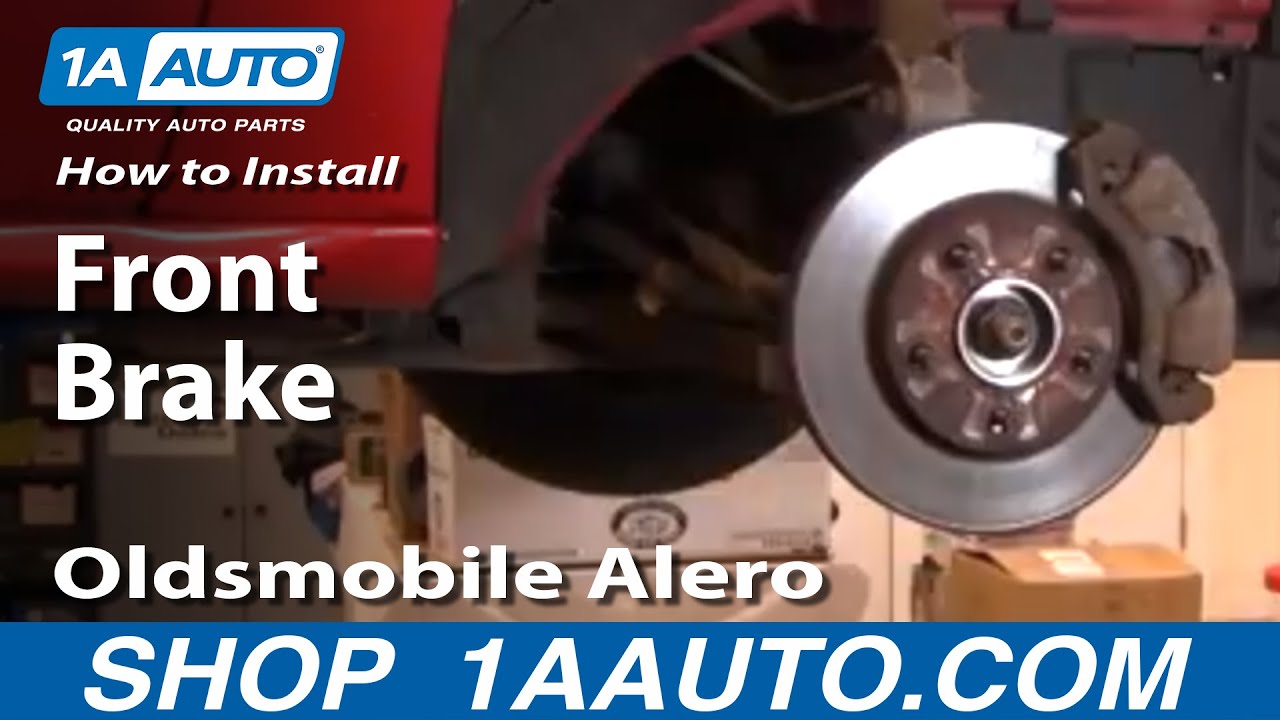
Created on:
Tools used
- Remove the lug nut covers   Remove the hub cap Loosen the lug nuts with the vehicle on the ground Raise the vehicle with a floor jack Secure the vehicle on jack stands Remove the lug nuts Pull of the wheel
- Turn the rotor by hand or turn the steering wheel to turn the rotor Remove two 12mm bolts from the brake caliper Push the caliper pistons in using a large C-clamp on the brake pad Pull the caliper aside Pull the brake pads off by hand Clean the slides with a wire brush
- Check the thickness of the brake pads Check the brake pad wear indicator Check for gouges on both sides of the rotor
- Remove two 13mm bolts from the brake caliper bracket with a breaker bar or a ratchet and pipe Pull off the brake caliper bracket Pull the rotor off
- Slide the rotor on Thread one lug nut to hold the rotor in place Clean the brake pad slides with a wire brush Put the bracket back into place, start the 13mm bolts by hand Tighten the 13mm bolts to 65 foot-pounds of torque
- Install the new brake pads into the bracket with the tab on the rear side Put the caliper on Thread the 12mm bolts by hand Tighten the 12mm bolts to between 15-18 foot-pounds Unthread the place-holder lug nut
- Slide the wheel into place Start the lug nuts by hand Tighten the lug nuts preliminarily Lower the vehicle to the ground Tighten the lug nuts to between 90-100 foot-pounds in a crossing or star pattern Reattach the hub cap, aligning the valve stem Reattach the lug nut covers
- Pump your brakes repeatedly until they feel firm Test your brakes at 5 miles per hour and then 10 miles per hour Road test the vehicle
Brought to you by 1AAuto.com, your source for quality replacement parts and the best service on the Internet.
Hi, I'm Mike from 1A Auto. I hope this how-to video helps you out, and next time you need parts for your vehicle, think of 1AAuto.com. Thanks.
In this video, we're going to show you how to do a front brake job on this 2000 Olds Alero. This is a two-door and the process is same for any two-door or four-door car. The tools you'll need are jack and jack stands, 12, 13, and 19mm sockets, obviously you'll need a ratchet and you'll need either a breaker bar or a pipe for leverage, large C-clamp, wire brush and a Torque wrench.
Start off by removing your hub cab, if you don't have air tools, you'll want to loosen your lug nuts and then raise and support your vehicle and then remove the lug nuts and the wheel. Turn the wheel for easier access to the back of the caliper. Right in behind, your calipers are held in by two 12mm bolts: one there and one there. These should come apart pretty easily. We'll fast forward, here, as I remove those bolts the rest of the way. In order to get the caliper off, you might need to reduce some pressure on the brakes. You put your C-clamp right against your brake pad there and then on the caliper there. That, in turn, makes it nice and loose. The caliper comes right off. For now you can put your caliper right up here. Now, you can take your pads right out. You can see they have wear marks on them. These pads are in pretty good shape. Then just use your finger, you run the back of your finger on the disk and if you don't feel any really deep grooves, they are probably okay.
To get our disk off, we're going to remove this caliper bracket, which is two bolts here and then one down here. Okay, these bolts are 13mm and you're going to want a breaker bar or use a piece of pipe on a ratchet because these will be tight. They shouldn't be too bad though. Okay and I'll just fast forward as I change over to a ratchet and remove those bolts the rest of the way. To get the brackets off of here, the rotor comes right off.
Now, I'm going to show you reinstallation. You put the rotor right back on. You can there that that hub is new, that's actually what this vehicle needed, needed a new hub so we figured we'd just do a brake video while we do the hub. You see I put the disk on there and then I put a lug nut on just to hold it in place. Before we put this bracket on, it has stainless steel slide, use a wire brush and clean these out really well. Another thing you need to check before you put this back together is make sure that these slide back and forth, in and out very easily. Put these on. The bolts to hold the bracket you also want to tighten to 65 foot pounds.
You can see my old pads are still in pretty good shape. This is a wear indicator, this groove right here and since it's still there, there's plenty of life left in the pads. The rear pad, you always want to put . there is a tab here and you always want to put that towards the backside as far as the rotation. Now, push the pads in. Since your piston has already been reset, put that right down. It should fit nice and easy. Then start these two bolts in. Now these two bolts, you only want to do between 15 and 18 foot pounds. Just speed up here as I use an extension and then tighten that top one up. We'll speed through here as we straighten that out, remove that lug nut, put the wheel and tire back on and then we'll just preliminarily tighten those lug nuts with our impact wrench and torque them when we get them on the ground. Tighten the lug nuts between 90 and 100 foot pounds. Last but not least, line up the valve stem with the wheel cover, put it on and use your 19mm socket just to tighten the caps by hand. Last but not least, make sure you pump your brakes a bunch of times and then do a stop from five and ten miles an hour before you road test your vehicle and make sure everything is working correctly.
We hope this helps you out. Brought to you by www.1AAuto.com, your source for quality replacement parts and the best service on the Internet. Please feel free to call us toll-free, 888-844-3393. We're the company that's here for you on the Internet and in person.
Tools used
- Loosen the 19mm lug nuts with the vehicle on the ground Raise the vehicle with a floor jack Secure the vehicle on jack stands Remove the lug nuts Remove the 35mm hub nut Pull off the wheel
- Remove the two 13mm bolts from the caliper Pry off the caliper Remove the brake rotor
- Remove the three bolts that hold in the hub Disconnect the ABS sensor if you have one Reach in behind and remove the clip holding the hub For the center, use a large axle nut socket Once the center bolt is removed, simply pull the hub off the axle shaft If it doesn't come off, you'll need an axle puller or a gear puller. Do not use a hammer
- Once the new hub is ready, place it into position on the axle shaft Take the original bolts and reattach the hub
Brought to you by 1AAuto.com your source for quality replacement parts and the best service on the internet.
Hi, I'm Mike Green, one of the owners of 1AAuto. I want to help you save time and money repairing and maintaining your vehicle. I'm going to use my 20+ years' experience restoring and repairing cars and trucks like this to show you the correct way to install parts from 1AAuto.com. The right parts installed correctly. That's going to save you time and money. Thank you and enjoy the video.
In this video, we'll be removing the hub on this 1999 Pontiac Grand AM. This is Part One of Two. Again, it's the removal of the hub. Removing the hub on this car is basically the same as just about GM car from about 1993 to present. Maybe tools will vary a little bit, but the basic procedure is the same. That's any GM, any Buick, Chevy, Pontiac or Olds, Saber Bonneville, Impala, all those vehicles.
Here are the tools you'll need. Keep in mind that sizes may differ by application. You may also need an axle puller or a gear puller if your hub is stuck together.
We'll start by lifting up the car and securing it. Obviously, if you're going to use a floor jack and jack stands, make sure that you follow safety instructions. I'm going to take off the wheel.
I got the wheel off. Now, I'm going to the other side and I'm going to grab the tire, turn the wheels all the way to the left. That gets usually better access to the back of the brake caliper, which is the next thing I'm going to take off.
I remove the brake caliper and its 13 millimeter bolts one on top and one on the bottom. I have the luxury of an impact wrench. Now we've unbolted the caliper and I'm just going to grab hold of it and pull it off. It makes a little better if you have a tie on the spring here. This probably ought to do it. Basically, you might be able to just take this one off here and stick it on there and stick it out of the way. Just secure it with a piece of string or something so that it doesn't fall down in your way. I found a nice piece of wire here. I'm just going to wrap it around the caliper here just so if it does fall, something holds onto it and it doesn't fall in.
Now we're going to remove the brake rotor.
We can usually get to one bolt. I'll show you that. With the right tools, we can get to the second bolts. Those three bolts now hold in the hub and you can see I had my wrench on the top one.
I like to do this one first; it's the hardest one to get to. You can see here I got a 3/8 wrench with an extension and I can get in there nicely. It's not coming, so I can show you a little trick for some extra torque. Take a nice big wrench, run the smaller wrench. The key is to be holding the wrench against the nut so it doesn't come off and strip the head of the nut. Here it comes. Alright, this is also where having coated the backs will come in handy. Got that one out.
Now these two, I can easily get to with anything half inch or impact. The other one, we'll have to get once you turn the full steering column around. We'll just grab hold of the other wheel and turn it this way. That will make it easier to get to the third one. See if I can get this one.
What you do is just use this little tip: Just pull evenly. Don't just try and jerk it because you could knock something off. Just pull harder and harder and harder and eventually it will come.
Now what I'll do is I'll go around the car to the other side. I'm just going to grab hold of the wheel and turn it. There are a couple things here. Since this car is ABS, disconnect this ABS sensor.
Then this clip. I can just reach in behind and pull it off. That goes obviously with the hub. Here is, I hope you can see it. Get these guys out of the way. Here is my third bolt. I put my wrench on. Excuse me. Again, it's just so easy to hook onto there. Actually, the bolts aren't.
Now, I have in the past on these past on these cars, you end up just can't get the bolt out. The head breaks off or strips. What you can do. I think you can see this well enough, is you can use the sawzall, and it's actually not that bad. With a good blade, in about a minute, you can cut through the hub and then the bolt and it comes off. You just punch the bolt out the other side. Then you'll have to go down to the hardware store and get a new bolt that's the right length in size. Fortunately, on this car, we didn't have to resort to that. Now remove those bolts and go the next step.
I haven't taken those bolts all the way out yet. I'm going to remove this large center bolt first. You're really going to need an impact wrench and a large socket. I've got a 34 millimeter socket on there.
Now I've got the bolts off of that and I've got it off and actually I'm lucky here because this hub just pulled off of the axle shaft. Let me put it back on here for a second. Hopefully, if you car's good, everything will pull apart. But if it doesn't just pull apart, you'll want either an axle puller or a gear puller that basically adhere to the lug nuts and then the shaft goes in and pushes right against the axle or it clamps onto the flange here. The same thing. The bolt goes in and pushes. It's either a gear puller or an axle puller. You don't want to use a hammer. You do want to bend this with a hammer, because you'll end up ruining your CV joints. You want to press that out. I can remove my old hub. Basically, there's a connector. I'm pushing the axle out of there. I can push this axle without worrying about it too much. But you don't want to bang on it.
Obviously, this is my old hub. Here's my new hub, nice and shiny. You can see everything's the same. It's got the same connector on it. Everything on the back side is all the same. Let's make sure we have the original bolts here. Slide it right in.
Remember to check out our other videos for the installation of this hub. Brought to you by www.1AAuto.com your source for quality replacement parts and the best service on the Internet. Feel free to call us toll-free 888-844-3393. The company that's here for you on the Internet and in person. Thank you.
Tools used
- Thread through the ABS harness. Start the bolts and make sure the shield plate is in the correct place. Turn the wheel as needed to get better access to thread in the bolts. Torque the bolts between 55-60 foot pounds. Connect the ABS harness and clip the bracket in place.
- Put the rotor back on. Secure the caliper onto the brake disk. Bolt into place and torque to 55 ft lbs.
- Torque the lug nuts to 75 ft lbs. The center hub nut should be torqued to 85 ft lbs.
Brought to you by 1AAuto.com, your source for quality replacement parts and the best service on the internet.
Hi, I'm Mike Green. I'm one of the owners of 1A Auto. I want to help you save time and money repairing or maintaining your vehicle. I'm going to use my 20 plus years experience restoring and repairing cars and trucks like this to show you the correct way to install parts from 1AAuto.com. The right parts, installed correctly, that's going to save you time and money. Thank you and enjoy the video.
Okay, so part two, replacing and installing the hub on this '99 Pontiac Grand Am. This video will help you with just about any GM front-wheel drive car from about '93 to present. Maybe the parts are a little different, maybe the size of the wrench is a little different, but the procedure is about the same, and again we cover removing the hub in our other videos, same name, just part one.
Okay, here's a list of tools you're going to need. You are going to need 3/8'' drive tools because it's a little hard to reach one of the bolts in the hub, and you are going to need to use torque wrenches because you want to make sure you get these, these are all Driveline parts, so you want to make sure everything's put back together correctly.
This connector here needs to go in this way so we push that through. This bottom one is our easiest one, I'm just pushing the bolt through and pushing the hub on and getting this bolt started in. Obviously you want to make sure this plate's in the right place. Going to swap around here, and I'm going to get the bottom, the rear bottom bolt in, push it through, and thread it on. Then I'm going to go around to the other side and I'm going to turn the wheel and now I can get this top on in and through. Push on the hub so it's back against the steering knuckle that prevents you from cross turning anything. Okay, so now I've got my socket and 13 millimeter wrench and I'll get each one of them somewhat tight first then I'll tighten them up. These should be between 55 and 60 foot-pounds. This center hub nut should be between 75 and 85 foot-pounds. I did put my hub on and I tightened it with an impact wrench but then I loosened it up a half-turn or so, so it's not exactly tight. You actually have to wait until you put the tire on the ground to torque that up.
Now I'm going to torque my three hub mounting bolts and I'm torqueing them to 55 foot-pounds. In fact I can actually reach this one pretty well from the backside here, so I will. I can reach it but I can't see it. There it is. Okay, and now I'm going to connect my ABS sensor, take my harness from the hub, and I'm going to click it on to the bracket here which sounds easy but is just a little bit weird here. Okay, kind of clicked the wrong part on. There it is, clipped on and now I'm going to plug in the ABS harness from the car. So now I'll put the rotor back on. Now be careful not to touch the rotor with your dirty fingers. Then we're going to bring the brake caliper back down and gently take some force to press it back down on to the disc. Put those bolts back in. I'll put my two bolts back in, tighten those up, those are about 55 foot-pounds, going to put my wheel back on and then I'll lower it to the ground and go from there.
So what I'm doing here is before I put the wheel on, I'm just popping off this center cap, that way I'll be able to get through there. So I'll quickly run through, three bolts in the back of the hub, we torque those. ABS sensor is plugged in, brake caliper is on and torqued, and now I'm going to put the wheel on and the next thing you'll see is it down on the ground and we'll be torqueing up the lug nuts and the center bolt.
We've got the car on the ground; I'm going to go 85 pounds with this center nut as you can see. Then I'm going to back off to 75 pounds for the lug nuts, you want to do those in a star pattern. Put our center cap back on, and we're all set.
Brought to you by www.1AAuto.com, your source for quality replacement parts and the best service on the internet. Feel free to call us toll free (888)844-3393, the company that's here for you on the internet and in person. Thank you.
Tools used
- Remove hub cap or center cap if you have it. While your car is still on the ground, use your lug wrench to loosen your lug nuts. Jack up and secure your car with jack stands. Remove the lug nuts with your lug wrench. Remove the wheel and set aside.
- Use a screwdriver to force the pistons back in. Remove the two 12mm bolts to remove the calipers. Use a wire tie to fasten the caliper out of the way. Use your screwdriver to pry out your brake pads. Remove the two 15mm bolts on the caliper bracket to remove it. Remove the caliper bolt sleeves. Check their condition and clean them with a wire brush if necessary. Pull off the brake rotor. Hit the rotor with a rubber mallet or hammer if necessary. Take care not to damage the lug studs.
- Clean new rotor with brake cleaner. Insert your new pads into the brackets. Put your caliper bracket back on, and tighten the bolts to 55-60 ft lbs. Compress the caliper piston with a c-clamp to reset the pistons. Mount the caliper on the bracket and torque the bolts in to 20 ft lbs.
- Make sure to use a star pattern when putting your wheel lugs back on. Tighten to 75-85 ft lbs. Replace hubcap/center cap.
- Before driving the car again, start it up and pump the brakes a few times to get the pistons in the brakes in place. Test the brakes in your driveway before taking the car onto the road. Set your rotors by evenly braking from 30mph to 10mph, 50mph-30mph and finally 70mph to 40mph. This is best done on a straight back road without any traffic.
Brought to you by 1AAuto.com, your source for quality replacement parts and the best service on the internet. Hi, I'm Mike Green. I am one of the owners of 1A Auto. I want to help you save time and money repairing and maintaining your vehicle. I am going to use my 20 plus years experience restoring and repairing cars and trucks like this to show you the correct way to install parts from 1AAuto.com. The right parts installed correctly, that's going to save you time and money. Thank you and enjoy the video.
In this video we're going to replace pads and rotors, the front on this 01 Chevy Malibu. This is a pretty easy process. Pretty much regular tools. You'll need a lug nut wrench or your tire iron. You'll need some millimeter, probably metric sockets. I use the 1/2 inch on a couple of bolts which I didn't think was right. I'm pretty sure it wasn't. You'll probably need 12mm and maybe like a 15mm socket or if like on our car, your car has been worked on you will need some different sizes. Some brake parts cleaner or mineral spirits and a large C-clamp.
This car is a Malibu it's got the aluminum wheels, screwdriver right into this little key here. We're going to remove the wheel. If you are using hand tools, loosen the lug nuts while your tire is on the ground first then raise and secure the car. Follow the instructions on your jack and jack stands and I got the benefit of air tools so I am going to remove this wheel now. With my wheel off, I have now turned my wheels all the way to the right and you can see here's the brake caliper. Now, what you could do is you can check your brakes yourself. Just some light and right in here you can see that is your brake pad, okay. Actually on this car the pads look good on this side but don't let one side to be your deciding factor because now I am looking over here on the driver's side and you can see there's the pad on the driver's side. There is hardly anything left between the metal here and the rotor there. The driver's side definitely needs to be done and you should always do your brakes in pairs so we'll end up doing both sides. What you are going to want to do is you are going to want to loosen up or remove 4 bolts. The first 2 on this car, there are these inner ones here. These are actually 1/2 inch in size.
There is one there and there is one up here. That, when you remove those 2, this whole assembly will come off and you also want to remove these 2 here, these are 12mm. Those will just allow the caliper itself to come off with the bracket. I will remove those. Again, the inner ones are 1/2 inch and then these ones here are 12mm. I was kind of surprised by that but that is the way it is. Just so you would see it can be done. I am just going to use regular hand tools to get these apart. That's the inner one. Then up here, that is the upper one. Before I pick those all the way out, I am going to remove my upper ones. Once I got that loosened up, I basically just use my fingers. I just support the caliper a little bit. This will come out. If you do just want to change your pads, you could pull really hard on this caliper which forces the piston back in and now allows the caliper to come up and off because there is a little peg on your pads that hold the caliper on but I'm just going to remove these 2 inner bolts here. After removing those bolts all the way, the whole assembly comes up and off. Your pads are right inside here. Pull them out because that actually allows this whole assembly. This is your caliper. You want to hang it up here and the other pad will come out.
On this point the disc actually comes right off. New disc from 1A Auto. You could see it's all the same, same dimensions. I'm going to go right on there. What I like to do is just take 1 lug nut and put it on. It just makes things easier to go back together. You want to use some brake parts cleaner or mineral spirits and just wipe down the disc could mean the grease or playing it conservative that was in the packaging off. Now, you actually have to force this piston back into the caliper. You're going to need a large C-clamp. Now, we have the piston down with the caliper. Now you're going to stick your smaller 12mm bolts and bolt to your bracket back on here. You can just have it be hand tight. Here is our caliper and the inside side is the side with the cylinder here. You want to put these ones that have the wear tabs and these bumps here those go to the inside. My caliper's upside down so I am going to put my curve side down. Then, I am pushing this just right into their respective brackets. Push in. Then your outside ones don't have the little wear indicator on them. Let me just go down in and then push it into place.
Sometimes you got to start one side and force them into the other side. Now, assembly down on and I have already got my larger bolts kind of in place. I have got the top one started and now the bottom one. I got the bolt started and just a little, tighten them up. You want pull them tight, but not incredibly tight. You don't want to break the bolts or anything but probably about 55 to 60 foot pounds. Make sure our 12mm bolts are tightened here. This side is all set and now I am going to do the other side and then we'll put the tire back on. Now, with the car back on the ground. You are going to tighten your lug nuts and I am using a breaker bar. You want to tighten them to about 75 to 85 foot pounds. I just make it nice and tight and use a star pattern. Then, you put your cap back on. Now, when you road test the car what you want to do, first start it up, press the brakes 3 or 4 times. Then, put the car in gear. Make sure the brakes just hold the car still. Then, do like a back up, give yourself plenty of room. Do like a 5 or 10 mile an hour and stop. Make sure the brakes are the stopping the car and then go out on the road.
The first few times you press the brakes after you have done your front brakes. The brakes will not work that well so you want to pump them a few times and then be careful on the road test. We hope this helps you out, brought to you by www.1AAuto.com your source for quality replacement parts and the best service on the internet. Please feel free to call us toll free 888-844-3393. We're the company that is here for you on the internet and in person.
Tools used
- Remove the hub cap Loosen the lug nuts Raise and secure the vehicle Remove the lug nuts and set the wheel aside. Turn the wheels for easier access to the calipers.
- Remove the two 12mm bolts with a socket and breaker bar. Use a C-Clamp to compress the caliper piston. Pull the caliper off. Remove the brake pads and check the life of them. Observe the rotors; prepare a new rotor with brake cleaner if it is in need of replacement. Use a 13mm socket and breaker bar to remove the caliper bracket bolts. Remove the rotor.
- Disconnect the ABS sensor. Remove the 35mm socket to remove the hub nut. Put the wheel back on and lower the car to break the hub nut loose if necessary. Use a 13mm socket and breaker bar to loosen the three nuts on the back side securing the hub. Put an axle puller onto the hub and axle to break the axle free from the hub. Sometimes a solid thwack with a hammer is enough to break the axle loose, taking care not to hit it hard enough to damage the CV joint. Remove the 13mm nuts all the way and pull the hub off.
- Thread the ABS harness through and line the axle up into the center of the hub. Evenly tighten the three 13 mm bolts. Connect the ABS sensor harness. Torque the 13mm bolts to 65 ft lbs Put the hub nut on, put the wheel on, lower the car, and torque it to 173 foot pounds. Raise and secure the car, remove the wheel and continue.
- Put your rotor on the hub. Mount the caliper bracket and torque the 15 mm bolts to 65 ft lbs. Install the brake pads. Dab a little anti-seize grease onto the edges of the brake pads and insert them into the brackets Install the caliper, and torque the caliper bolts to 15-18 ft lbs.
- Put the wheel on and hand tighten the lug nuts. Lower the vehicle and torque the lug nuts to 90-100 ft-lbs in a star pattern. Pump your brakes and do a couple test stops before driving your car anywhere.
Brought to you by 1AAuto.com, your source for quality replacement parts and the best service on the internet. Hi, I'm Mike from 1AAuto. I hope this how to video helps you out, and next time you need parts for your vehicle, think of 1AAuto.com. In this video, I want to show you how to replace a front hub on this 2000 Olds Alero, this is a two door. Hub replacement is the same for any '99-'04 two or four door. Tools you need are jack and jack stands, 12, 13, 19, and a 35 millimeter socket. That 35 millimeter is one that a lot of people aren't going to have. You'll need a ratchet and a breaker bar or maybe a pipe for some extra leverage. Large c-clamp, wire brush, torque wrench, and possibly an axle puller.
Start off by removing your hub cap. If you don't have air tools, you'll want to loosen your lug nuts, then raise and support your vehicle, then remove the lug nuts and the wheel. Turn the wheel for easier access, back the caliper. If you went in behind your calipers are held on by two 12 millimeter bolts, one there and one there. This should come off for you easily. We'll fast forward here as I remove those bolts the rest of the way. In order to get the caliper off, you might need to reduce some pressure on the brakes. You put your c-clamp right against your brake pad there, and then on the caliper there. Now, you can turn and loose, the caliper comes right off, and now you can just put the caliper right up here. Now, you can take your pads right now. You could see that they have wear marks and these pads are still in pretty good shape, and then, just use your finger and kind of run up on the ... run your finger on the disks, and if you don't feel any really deep grooves, they're probably okay.
To get our disks off, we're going to remove this caliper bracket, which is two bolts here, then one over here. These bolts are 15 millimeters and you're going to want like a breaker bar or use a piece of pipe on a ratchet, so these will be tight. I'll just fast forward as I change over to a ratchet and remove those bolts the rest of the way. The bracket's off here. Rotor comes right off. On the backside, you've got your ABS connector. Just pull back on this little tab, unplug that, and then, you'll want to use Phillips screwdriver, and remove that. Now, your hub is held on by three bolts. One here at the top, one down here, and then there's one over on the opposite side. Using an impact wrench, you want to probably loosen this at the start. You can actually put your wheel back on here right now, lower down on the ground, then use a big breaker bar or something to remove it to 35 millimeter. Now, I'm using 3/8 inch drive tools and just makes it a little easier to get back in there. A longer bar, because generally these are pretty tough, and the 13 millimeter, it came off pretty easily. I'll just fast forward here as I loosen but I don't remove the three bolt yet.
Here in this picture, you can see I've put a axle press or puller onto my hub, so there's the two kind of hands that reach behind the hub and hold it while they ... the bolt through the middle pushes the axle through. Quite honestly, I've done a lot of these hubs, and usually, what you can do is take a hammer and just give that axle a quick whack and they'll break it free. This is the first one in about a hundred that I actually had to use the press on. I'll just speed up here as I remove the bolts the rest of the way. The bolt's out. Pull the hub. Now, you may have to push your axle back in order to get the parts, we're able to kind of push the axle to the side. That comes out. A new hub from 1AAuto. It's got the ABS pigtail and everything, just like the original. Fit it in. Make sure that that connect to those screw. I'm going to speed it up. Basically, you just push it on and you might need to twist it just a little bit just to get it to line up with the axle, and then push it back and start one of the bolts in, then start the other two bolts. I don't tight them up all the way. You definitely want to start all three bolts first, then tighten them up most of the way, and then we will hook up our ABS lead, and then you need to torque those bolts on. Then, you want to torque this to 65 foot pound and I'll start with the back one. I'll put this parts in place. I got this bolt torqued up, and then, my harness back in place and my connector reconnected. I'll fast forward as I just change the position of the wheel, and then torque those other two bolts again 65 foot pounds.
Put the rotor back on, and just to help me get it back again, I usually put a lug nut on. Before we but this bracket on, it has stainless steel slides. Use a wire brush and clean this out really well. The other thing to check before you put this back together is make sure that this slide back and forth, in and out pretty easily. Put this on. The bolts that hold the bracket, you also want to tighten to 65 foot pounds. Basically, you could see my old pads are still in pretty good shape. This is a wear indicator that's grooved right here and it's still there, there is no life left in the pads. On the rear pods, you always want to put ... there is a tab here and you always want to put that towards the back side as far as the rotation go. Push that pads in. This is your ... your piston's already been reset. Put the brake down real nice and easy and just tighten these two bolts in.
Now, these two bolts, you only want to do between 15 and 18 foot pounds. I'm going put my center nut on there, and I'm just going to tighten it up preliminarily. Let's just speed up here as I use an extension and then tighten that top one up. Speed through here as we straighten that out, remove that lug nut, put the wheel entire back on, and then we'll just preliminarily tighten those lug nuts with our impact wrench and torque them when we get them on the ground. We'll tighten the lug nuts between 90 and a 100 foot pound. Now, you want to torque this center nut to a 173 foot pounds, and last but not least, line up the valves in with the wheel cover, put it on, and use your 19 millimeter socket just to tighten the caps by hand. Any time you take your brakes part, make sure you pump them a lot of times, and then do test stops from 5 and 10 miles an hour before you road test the vehicle.
We hope this helps you out, brought to you by www.1AAuto.com, your source for quality replacement parts and the best service on the internet. Please feel free to call us toll-free, 888-844-3393. We're the company that's here for you on the internet and in person.
BKA52047
877-844-3393
Monday - Friday 8:00am - 9:30pm ET
Saturday - Sunday 8:00am - 4:30pm ET
Specify your vehicle's year, make and model to guarantee fit.
This part does not fit a .






